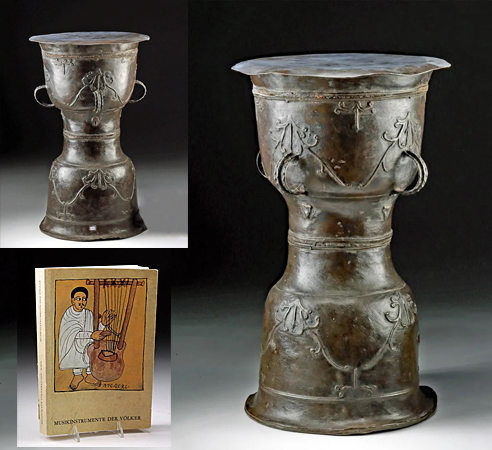
Owner: HWMC
Catalogue #: 2AS-IDST-90
Gongs
Indonesia 'Moko Drum’- Alors Island - 19th c.
Lesser Sunda, Indonesia
Culture: Indonesian (Alor)
Metal – Brass
19th century
Diameter: 13.1″; Height: 21.3″ (33.3 cm x 54.1 cm)
Idiophones – Struck Idiophones – Gongs
A remarkable 19th century hourglass-shaped brass drum known as a moko drum from Lesser Sunda, Indonesia of the Alor Island culture. It is decorated with ribbons of scrolling tendrils that encircle the body. The openwork handles as well as the field of the vessel are decorated with bands of intricate patterns such as ‘beaded’, rope motifs, and crosshatch motifs perhaps inspired by woven textile patterns. The top of the drum is enclosed with a disk of sheet brass to serve as the tympanum, while the bottom is open.
Mokos are still used today for ritual celebrations and as part of the marriage exchange on the island of Alor in the Indonesian archipelago. Traditionally a groom would give a moko to his wife’s family as part of a dowry – and there is an endearing saying in Alor, “No moko, no marriage!” Mokos were also traded for agricultural produce. On occasion, mokos were used as musical instruments for significant events. Older mokos are coveted and thought to house ancestral spirits.
This piece was exhibited in the Museum fur Volkerkunde or Museum of Ethnology (now the Weltmuseum Wien or World Museum Vienna) in Vienna, Austria as part of the “Musikinstrumente der Volker” (“Musical Instruments of the Nations”) exhibition in 1975. It was also published in the catalog of the exhibition in “Musikinstrumente der Volker: Aussereuropaische Musikinstrumente und Schallgeraete: Systematik und Themenbeispiele” by Alfred Janata (Vienna: Sammlungskatalog des Museums fur Volkerkunde, 1975), pp. 26-27, cat. no. 18.
